Abstract
We examine the composition of metals in the waters of the southern tributaries of Lake Baikal as well as comparing it with the composition of metals in bottom sediments and calculating the water migration coefficients of metals. The territory of the southern part of the lake drainage basin was regionalized according to the ability to ensure a particular water composition. The contribution from the southern tributaries to the chemical composition of Lake Baikal water was evaluated. It was found that the composition of macroelements and trace elements in the waters varies over a broad range. There occur waters with salt contents far exceeding those in Baikal water and its main tributaries as well as with considerably lower salt contents. Macroelements in the waters of all the streams studied are absolutely dominated by calcium, whereas the waters differ greatly in magnesium and sodium contents. Trace elements in the waters of the rivers on the southwestern coast are dominated by strontium, vanadium and molybdenum, which significantly differs them from the waters of the rivers of the southeastern coast, Lake Baikal and its main tributaries. The values of the water migration coefficients as calculated for the macroelements in the waters of the southern and main tributaries of Baikal are similar. The water migration coefficient of trace elements for the river waters in the study area differ greatly from the coefficients for the waters of the main tributaries of Baikal. The reason behind this is the existence of sources of dissolved matter, such as rocks and deep underground water, with their composition not characteristic for corresponding landscapes. The contribution from the southern tributaries to the macroelement composition of Lake Baikal waters can be estimated at the range of 5 to 30% depending on the selected tracer metals. The contribution from the southern tributaries to the trace element composition of the Baikal waters defies estimation because of their much higher concentrations in the rivers when compared with Baikal water. The differences in the trace element concentrations in the water of Baikal water and of its tributaries are caused by their migration in the composition of organic matter. In consequence of a long period of water exchange in Baikal, this matter is deposited or decays thus promoting the removal of trace elements from solution.
Similar content being viewed by others
References
Sorokovikova, L.M., Sinyukovich, V.I., Khodzher, T.V., Golobokova, L.P., Bashenkhaeva, N.V., and Netsvetaeva, O.G., Input of Nutrient Elements and Organic Matter to Lake Baikal With River Waters and Atmospheric Precipitation, Meteorol. Gidrol., 2001, no. 4, pp. 78–86 [in Russian].
Khodzher, T.V. and Sorokovikova, L.M. An Assessment of the Entry of Soluble Substances From the Atmosphere and With the River Runoff Into Lake Baikal, Geogr. Prir. Resur., 2007, no. 3, pp. 185–191 [in Russian].
Votintsev, K.K., Glazunov, I.V. and Tolmacheva, A.P., The Hydrochemistry of the Rivers of the Lake Baikal Drainage Basin, Moscow: Nauka, 1965 [in Russian].
Kuzmin, V.A., Chemical Composition of the Waters of the Tributaries of Southwestern and Southern Baikal and Its Association with the Natural Situation, Geogr. Prir. Resur., 1998, no. 1, pp. 70–23 [in Russian].
Sinyukovich, V.N., Relationships Between Water Flow and Dissolved Solids Discharge in the Major Tributaries of Lake Baikal, Water Resour., vol. 30, issue 2, pp. 186–190.
Grebenshchikova, V.I., Lustenberg, E.E., Kitaev, N.A., and Lomonosov, I.S., Geochemistry of the Environment of Cisbaikalia (Baikal Ecological Testing Area), Novosibirsk: Geo, 2008 [in Russian].
Chebykin, E.P., Sorokovikova, L.M., Tomberg, I.V., Vodneva, E.N., Rasskazov, S.V., Khodzher, T.V., and Grachev, M.A., Current Statusof the Waters of the Selenga River on the Territory of Russia as Deduced From Main Components and Trace Elements, Khimiya v Interesakh Ustoichivogo Razvitiya, 2012, vol. 20, no. 5, pp. 613–631 [in Russian].
Granina, L.Z., Baryshev, V.B. and Grachev, A.M., Study of the Elemental Composition of Suspended Sediments in Lake Baikal and Its Tributaries by X-ray Fluorescent Analysis Based on Synchrotron Radiation, Nucl. Instrum. Meth. Phys. Res. A, 1995, vol. 359, issues 1–2, pp. 302–304.
Semenov, M.Yu., Spolnik, Z., Granina, L., and Van Grieken, R. Ultra-thin Window Electron Probe Microanalysis of Suspended Particles in Tributaries of Lake Baikal, Siberia, Int. J. Environ. An. Ch., 2005, vol. 85, issue 6, pp. 377–386.
Tomberg, I.V., Sorokovikova, L.M., Netsvetaeva, O.G., Sez’ko, N.P., and Zhuchenko, N.A., Chemical Composition and Trends of Oxidationof Snow Waters and Waters of South Baikal Tributaries, Opt. Atmos. Okeana, 2016, vol. 29, no. 6, pp. 516–520 [in Russian].
Bashenkhaeva, N.V., Sinyukovich, V.N., Sorokovikova, L.M., and Khodzher, T.V., Organic Matter in the Water of the Selenga River, Geogr. Prir. Resur., 2006, no. 1, pp. 47–54 [in Russian].
Khodzher, T.V., Domysheva, V.M., Sorokovikova, L.M., Sakirko, M.V., and Tomberg, I.V., Current Chemical Composition of Lake Baikal Water, Inland Waters, 2017, vol. 7, no. 3, pp. 250–258.
Suvorov, E.G. and Titaev, D.B., The Structure of Landscapes of Southern Cisbaikalia, Geogr. Prir. Resur., 1999, no. 4, pp. 20–30 [in Russian].
Snytko, V.A., Semenov, Yu.M., Semenova, L.N., and Danko, L.V., Landscape Geochemistry of the Lake Baikal Watershed Basin, Geogr. Prir. Resur., 2007, no. 3, pp. 191–197 [in Russian].
Afanasyev, A.N., Water Resources and Water Balance of the Lake Baikal Drainage Basin, Novosibirsk: Nauka, 1976 [in Russian].
Falkner, K.K., Measures, C.I., Herbelin, S.E., Edmond, J.M., and Weiss, R.F., The Major and Minor Element Geochemistry of Lake Baikal, Limnol. Oceanogr., 1991, vol. 36, issue 3, pp. 413–423.
Falkner, K.K., Church, M., Measures, C.I., Lebaron, G., Thouron, D., Jeandel, C., Stordal, M.C., Gill, G.A., Mortlock, R., Froelich, P., and Chan, L.-H., Minor and Trace Element Chemistry of Lake Baikal, Its Tributaries, and Surrounding Hot Springs, Limnol. Oceanogr., 1997, vol. 42, issue 2, pp. 329–345.
Ecological Atlas of the Lake Baikal Basin. URL: http://bic.iwlearn.org (Accessed October 10, 2018) [in Russian].
Kuz’min, M.A., Bychinskii, V.A., Kerber, E.V., Oshchepkova, A.V., Goreglyad, A.V., and Ivanov, E.V., Chemical Composition of Sediments in Baikal Deep-Water Boreholes as a Basis for Reconstructions of Climatic and Environmental Changes, Russ. Geol. Geophys., 2014, vol. 55, issue 1, pp. 1–17.
Pellinen, V.A., Cherkashina, T.Yu., Pashkova, G.V., Gustaytis, M.A., Zhurkova, I.S., Shtel’makh, S.I., and Panteeva, S.V., Assessment of the Ecological Status of Soil Cover of Olkhon Island (From Experimental Data), Izv. Irk. Univ., Ser. Nauki o Zemle, 2016, vol. 16, pp. 79–90 [in Russian].
Perel’man, A.I., Landscape Geochemistry, Moscow: Vyssh. Shk., 1975 [in Russian].
Pisarskii, B.I., Formation Patterns of the Groundwater Flow of the Lake Baikal Drainage Basin, Novosibirsk: Nauka, 1987 [in Russian].
Semenov, M.Yu., Sandimirova, G.P., Korovyakova, I.V., Troitskaya, E.S., Khramtsova, T.I., and Donskaya, T.V., Comparative Assessment of Soil Weathering Rates in the Landscapes of the Northern Slope of the Khamar-Daban Ridge, Geol. Geophys., 2005, vol. 46, no. 1, pp. 50–59 [in Russian].
Turkina, O.M., Urmantseva, L.N., Berezhnaya, N.G., and Skublov, S.G., Formation and Mesoarchean Metamorphism of Hypersthene Gneisses From the Granulite-Gneiss Block (Sharyzhalgai Uplift in the Southwestern Siberian Craton), Russ. Geol. Geophys., 2011, vol. 52, issue 1, pp. 97–108.
Shkol’nik, S.I., Reznitsky, L.Z. and Barash, I.G., Possibility of Identification of Back-Arc Paleobasins From High-Grade Orthometamorphite Rocks: Evidence From basic Crystalline Schists of the Slyudyanka Crystalline Complex, South Baikal Region, Geochem. Int., 2011, vol. 49, issue 12, pp. 1177–1194.
Author information
Authors and Affiliations
Corresponding authors
Additional information
This work was done under core projects (03452019-0008 and 0281-2019-0002) with the support from the government of Irkutsk oblast and the Russian Foundation for Basic Research (17-45-388054 and 17-29-05068).
Russian Text © The Author(s), 2019, published in Geografiya i Prirodnye Resursy, 2019, Vol. 40, No. 4, pp. 93–103.
Rights and permissions
About this article
Cite this article
Semenov, M.Y., Semenova, L.N., Semenov, Y.M. et al. Metals in the Waters of the Southern Tributaries of Lake Baikal. Geogr. Nat. Resour. 40, 362–372 (2019). https://doi.org/10.1134/S1875372819040085
Received:
Published:
Issue Date:
DOI: https://doi.org/10.1134/S1875372819040085




